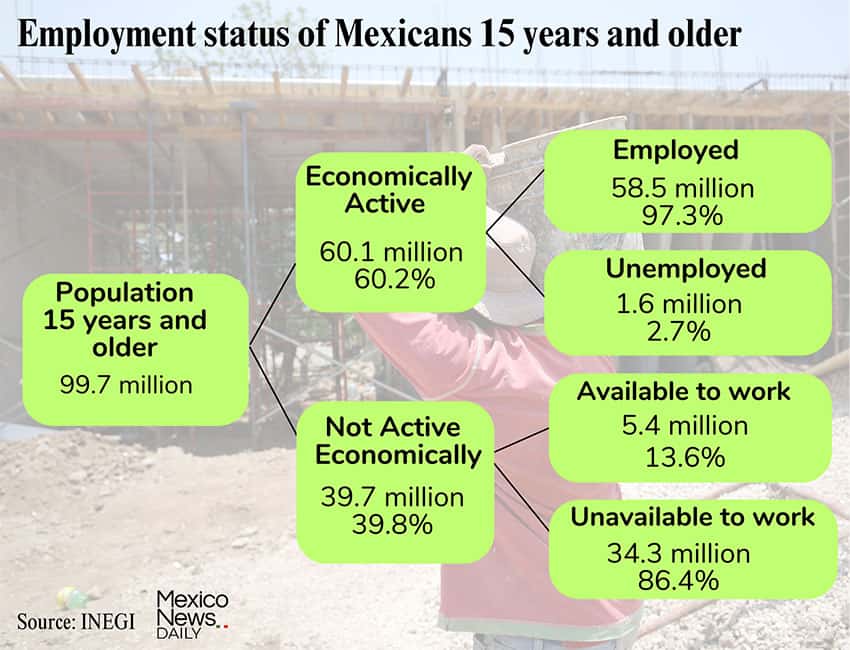Unemployment in Q1 of 2023 decreased to lowest level on record

Mexico had a good start to the year in economic terms, with unemployment declining to its lowest level on record in the first quarter and gross domestic product (GDP) increasing 3.7% compared to the first three months of 2022.
The national statistics agency INEGI reported Monday that the unemployment rate was 2.7% in the first quarter of 2023, down from 3.5% a year earlier.
The rate is the lowest since comparable records were first kept in 2005.
INEGI said that Mexico’s economically active population (PEA) in the first quarter was 60.1 million people, an increase of 2 million from a year earlier. The PEA is made up of people aged 15 and older who are in work or looking for work.
While 58.5 million people — 97.3% of the PEA — had jobs in the first quarter, 4.3 million of that number were underemployed, INEGI said. The total number of unemployed people was 1.6 million.
Ana Bertha Gutiérrez, a labor market expert with the Mexican Institute for Competitiveness, a think tank, said that high inflation may have helped lower the unemployment rate.

The 2.7% unemployment rate “might reflect greater participation in the economy due to factors like inflation or the need to cover … [life’s] basics. … [Those factors] can incentivize people to join the workforce more quickly,” she said.
People can’t survive for very long without income, so they look to find work as quickly as possible, Gutiérrez said.
Gabriela Siller, director of economic analysis at the Mexican bank Banco Base, said that the growing nearshoring phenomenon — the relocation of companies to Mexico to be close to the United States market — and associated job creation helped drive unemployment down to a record low.
While the vast majority of Mexicans who are able to and want to work have jobs, over half of them work in the informal sector, meaning that they don’t pay tax and don’t have access to social security benefits.
INEGI noted that 32.2 million people with jobs — 55.1% of the employed population — were working in the informal sector in the first quarter of the year.
The three states with the highest percentage of informal sector workers were Oaxaca (80%), Guerrero (79.3%) and Chiapas (73.9%). The three states with the lowest percentages were Chihuahua (34.1%), Coahuila (34.6%) and Nuevo León (36.7%).

INEGI compiled its employment data via a national survey conducted in the first quarter of the year.
The Mexican Social Security Institute (IMSS) reported separately that the average daily base salary of IMSS-affiliated workers at the end of March was 525 pesos (just under US $30), an 11.2% increase compared to a year earlier.
Meanwhile, GDP increased 3.7% in seasonally-adjusted terms in the first quarter of 2023 compared to the first three months of last year, INEGI reported.
Data published last Friday showed that the tertiary, or service sector, of the economy grew 4.2% in annual terms, while the primary and secondary sectors recorded growth of 2.9% and 2.4%, respectively.
INEGI also reported that the economy grew 1% in Q1 compared to the final three months of 2022. The primary sector declined 2.8% compared to Q4 of last year, but the secondary and tertiary sectors recorded GDP growth of 0.6% and 1.5%, respectively.
“The tertiary sector has defied a series of obstacles, including high inflation,” said Andrés Abadia, chief Latin America economist at Pantheon Macroeconomics.
By far, Mexico’s biggest economic sector is its tertiary sector, or services sector. And it did not disappoint in Q1, where it saw 4.2% growth in annual terms, the highest jump of Mexico’s three sectors.
The annual and quarter-over-quarter growth figures were both 0.1 percentage points lower than those based on preliminary data reported in late April.
Data shows that Mexico’s economy grew for a sixth consecutive quarter in the first three months of 2023, a positive streak that hadn’t occurred since 2016 and 2017.
President López Obrador last Friday described Mexico’s unemployment and growth rates as “good news.”
He also highlighted the strength of the peso (about 17.65 to the US dollar on Tuesday morning) and noted that inflation fell to 6% in the first half of May.
While the economy is growing, the think tank México ¿cómo vamos? noted that GDP per capita is currently at 2015 levels. GDP per capita had been on the rise but fell sharply in 2020 due to the COVID-19 pandemic and associated restrictions, and hasn’t yet recovered.
“The pie is growing, but there are more consumers,” said economist Pablo Cotler, offering a simple explanation of the situation.
With reports from El Financiero, El Economista and Reforma
Source: Mexico News Daily

